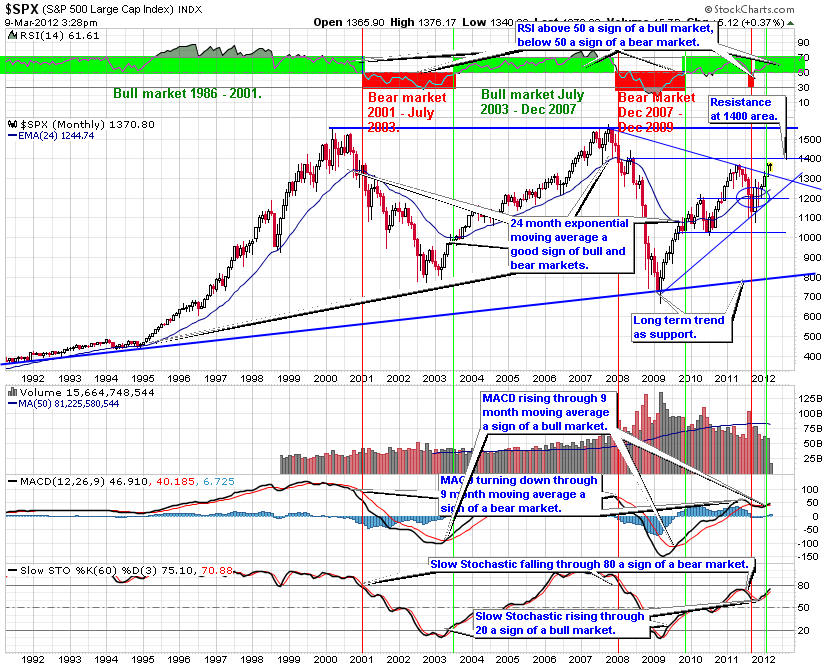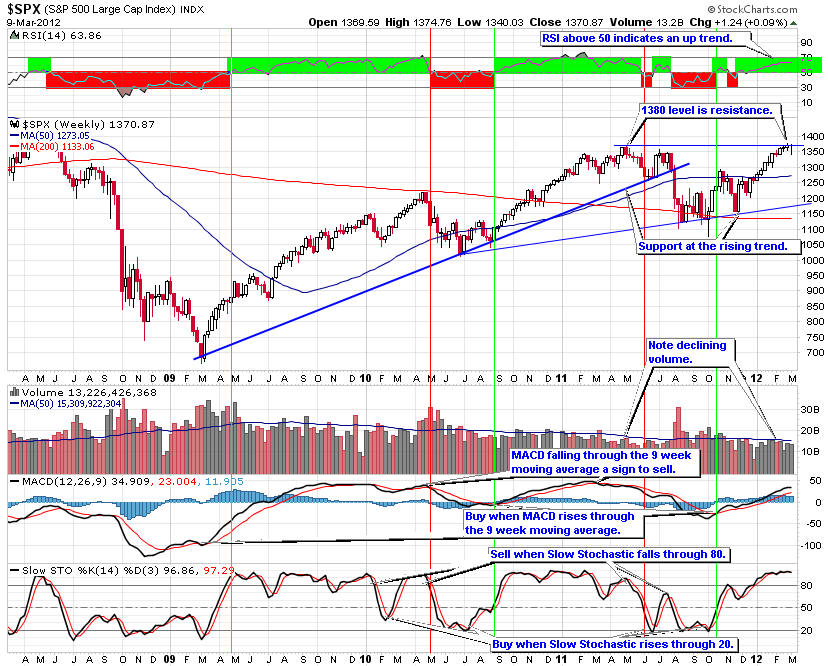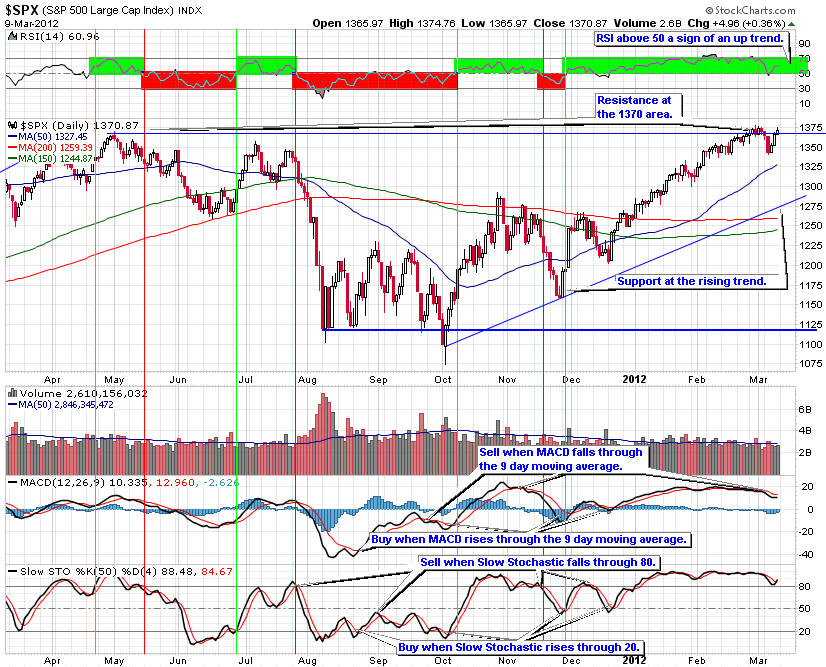

This is a monthly chart for the S&P 500 showing 20 years of performance. Since this index is the one used by professional traders, it is important to understand how it is performing. This chart is also excellent at defining the longer term trends for the market.
The end of the bear market and the stock market bottom came at the long term rising trend. Shortly after the monthly Slow Stochastic rose through 20 then the MACD rose through its 9-month moving average. Finally, the RSI climbed through the 50 level, though it is testing this bull-bear market indicator now. Most recently, the S&P 500 crossed through the 24-month exponential moving average. As long as it remains above this level, a bull market is in place.
In early May 2010, the market pulled back as it tests the breakout through the 24-month exponential moving average. Monitor whether the 24-month EMA holds as support in the next month.
The RSI is below 50, a sign of a down trend, though it is close to the 50 level. The MACD is trending up. Monitor how it handles the zero level to get an idea of the strength of this move. The Slow Stochastic is trending up as it pushes through the 50 level, a potential resistance area.
From a monthly chart perspective, the rally remains in tact as the 24-month EMA is still acting as support and the indicators have not turned negative.
For now, I intend to invest as though we are in a more normal market that will see rallies and then pull backs. The rally of the last 12 months came as a rebound from an oversold condition as investors feared the worse. Going forward, we will experience market rallies and pull backs as the economy struggles to expand. The overall trend will be sideways in a range of 930 on the low and 1,250 at the high.
You can click on the link below to see a current version of this chart.

The four-year weekly S&P 500 trend chart shows that the drop in the market that began in early May 2010. There is support at the 50-week moving average that has held, so far.
RSI is below 50, a sign of a down trend. The MACD has reached a high point where it turned down through the 9-week moving average, giving a sell sign. The Slow Stochastic fell through 80, a sell sign and it is approaching 20.
The weekly chart pattern indicates the S&P 500 turned down, though it might be finding support at the 50-week moving average. If it holds, it is a good buying opportunity. Otherwise expect another move down to the 930 level.
You can click on the link below to see a current version of this chart.

On the daily chart of the S&P, the index broke through support of the rising trend, the 50-day moving average and the 1,150 level. The 200-day moving averages also failed as support. It will act as resistance on the way up.
RSI is below 50 indicating a down trend. The MACD is turning up through the 9-day moving average, giving a buy sign. The Slow Stochastic rose through 20 giving another buy sign.
The 150-day moving average is an excellent indicator of the longer term trend for the market. When the slope of the 150-day moving average is positive (trending up) it means the market trend is up. Should the slow of the 150-day moving average become negative (trend down) the market is trending down. At this time, the 150-day moving average is flat. Should it turn down, it will tell us the market is trending down.
The daily chart of the S&P 500 is trying to push through resistance at the 200-day moving average. If it can regain this level, it will be a positive sign for the markets.
For 2010, I am expecting the market to trade in a range 1,250 area as the high 930 as the low.

Given this analysis of the S&P 500 trend line charts, it is important to position your portfolio for a market that is more likely to trend in a range with cyclical rallies and pull backs.
Selecting the right sectors and stock picking will become more important to your success. Look to buy on dips in the market to important support levels. Then add down side protection at interim high points using trailing stops and protective put options to help improve the overall return.
The charts of the S&P 500 trend lines provide a good way for investors to align their portfolios with the overall market trends. Picking the right sectors and stocks will become even more important. Look to buy on dips in the price of the S&P 500 trend charts on the next pull back.
Be sure to use proper capital management techniques including trailing stops, protective put, covered call options and position sizing. When the pull back ends, look to add to long positions with stocks and ETFs from the sectors that are likely to outperform the overall market. Keep in mind, Warren Buffett's first rule of investing is to not lose money. Be patient waiting for good entry points.
As of the end of May 2010, our Stock Portfolio was up 8.1 percent and our sector portfolio was up 9.0 percent. The market as measured by the S&P 500 was down 2.1 percent.
Request a membership with a free four week trial subscription with no risk or obligation.
If you decide to continue at the end of the four-week trial your subscription starts automatically. If you decide to cancel before the end of the trial, you will not be charged a thing. No risk, no obligation.
You have nothing to lose and a lot to gain as we have beat the market every year since our inception.
If you are interested in a free monthly newsletter on the stock market trends, please send an email to [email protected] with your email address stating you wish to receive the Free Monthly Newsletter and you will be added to the list.